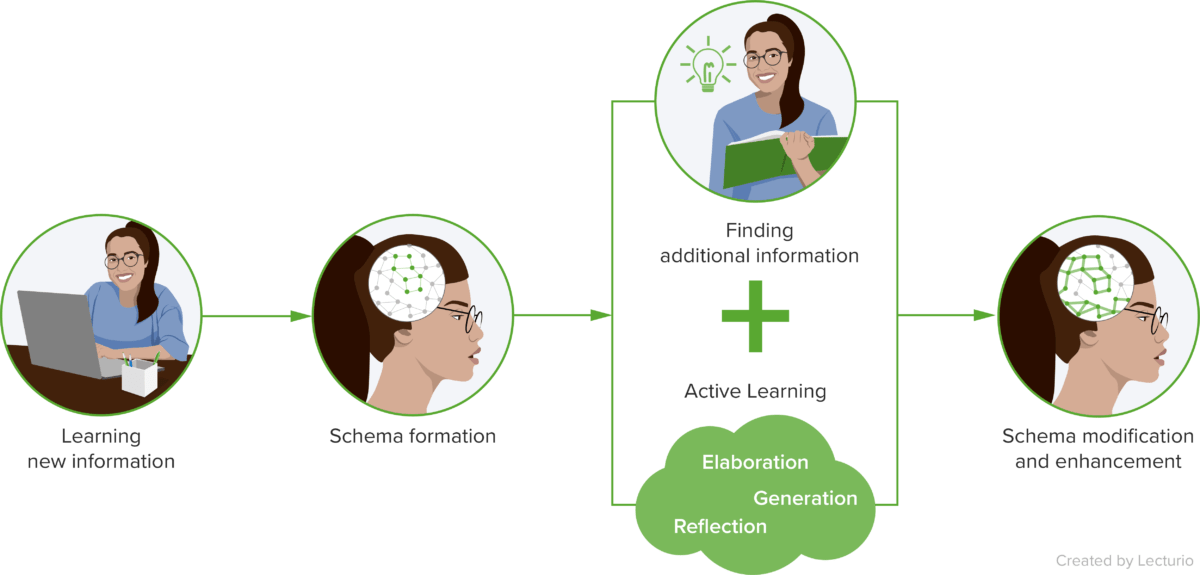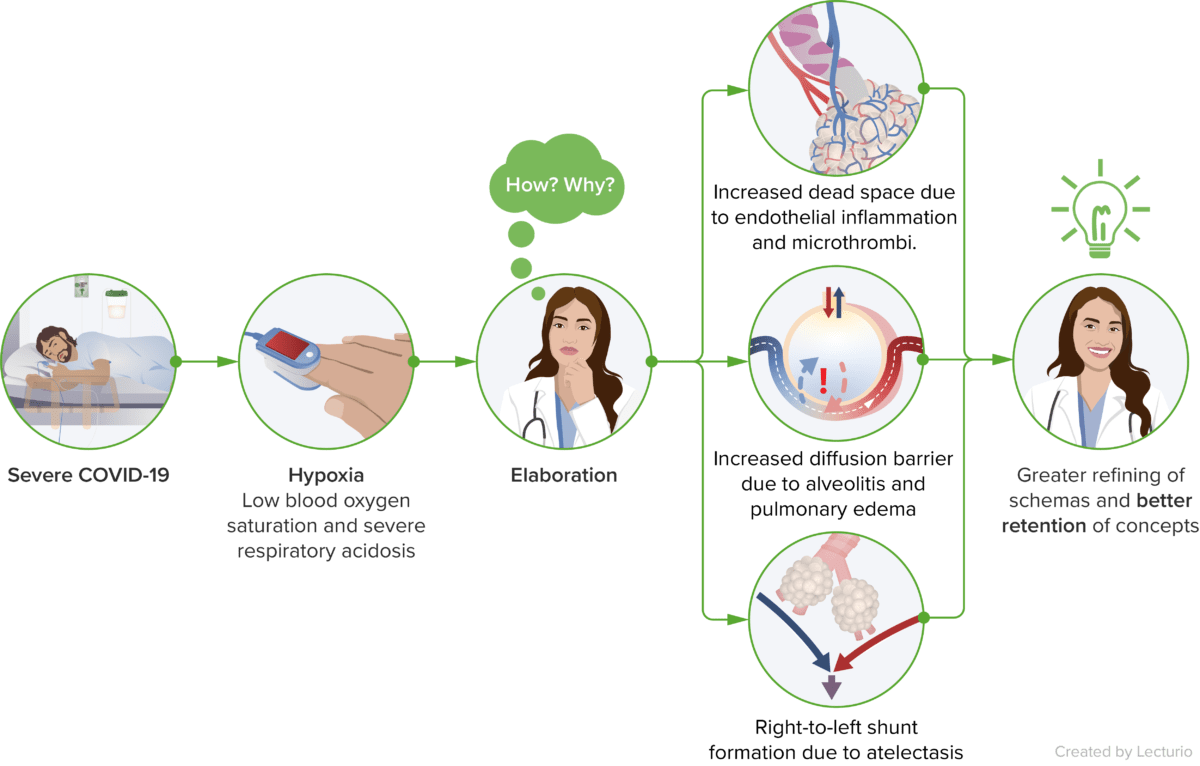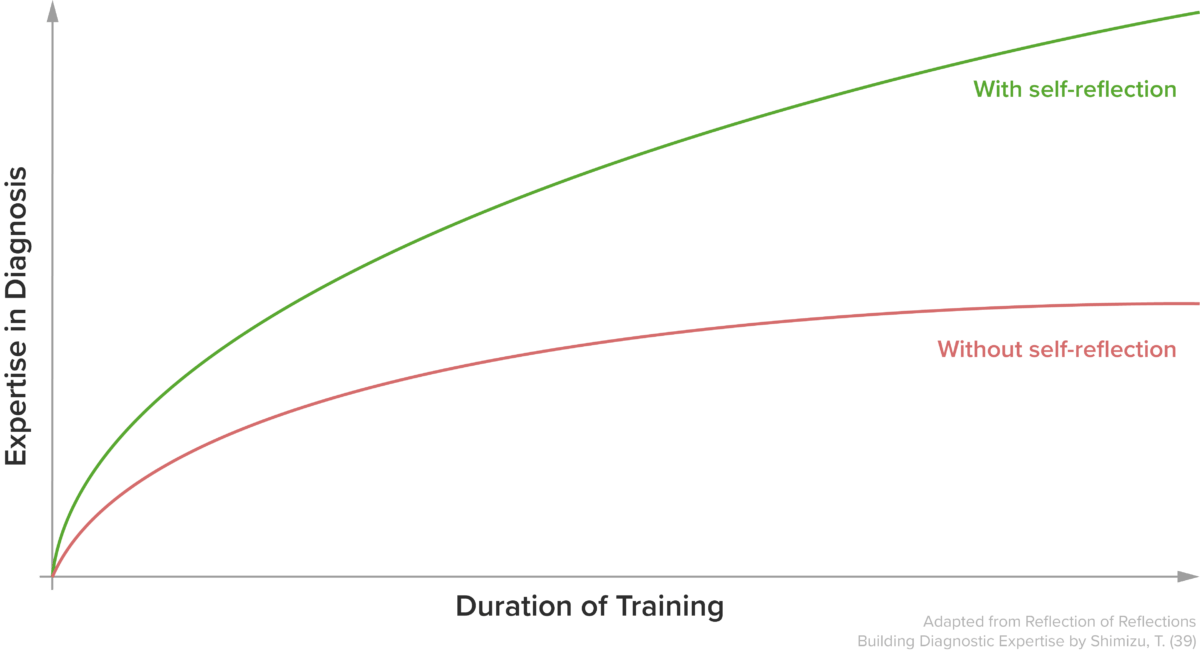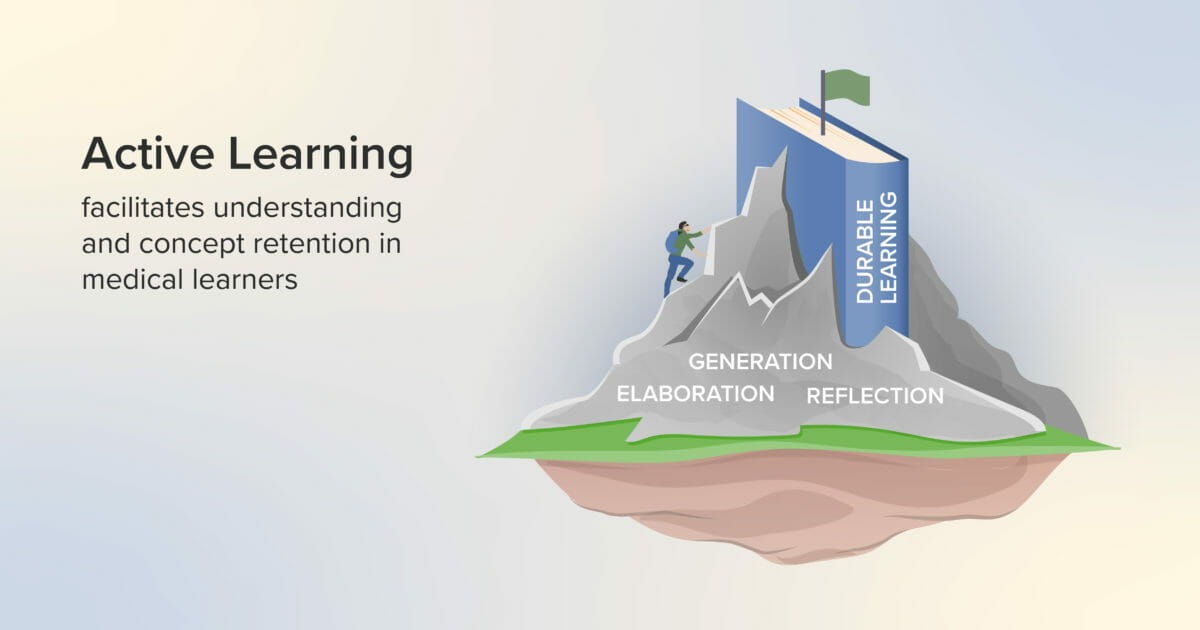In active learning, students are not just sitting and listening, but are actively engaged in dynamic tasks that promote knowledge retention. Manageable and effective active learning methods that can be leveraged by faculty in physical and digital classrooms include elaboration, generation, and reflection.(1–5)
What Is Active Learning?
Meaningful classroom learning depends on rich interaction between the educator and the student. The educator designs instruction and delivers content. The student must process sensory input, encode, store, and retrieve that information and connect it to already known concepts. Instructors need to be informed about best practices in education and equipped to guide students toward the best methods for making their learning durable.
Definition
Active learning strategies engage students in their own learning process. In their influential report “Active Learning: Creating Excitement in the Classroom,” authors Bonwell and Eison define active learning as “instructional activities involving students in doing things and thinking about what they are doing.”(6)
Key traits of active learning strategies include student use of higher-order thinking and metacognition.(6) A broad definition of active learning encompasses practices that we have already discussed in previous articles, such as spacing, interleaving, and retrieval-based strategies.
While there are overlapping characteristics between active learning methods and formative assessments (used to evaluate student understanding), active learning involves students engaging dynamically with the content being learned (as opposed to passively watching a lecture or reading a textbook) with the goal of building new knowledge or skills.(7)
Simply put, active learning can be defined as “students’ efforts to actively construct their knowledge.”(2)
Schemas
Constructivist learning theory, developed by Piaget and others, asserts that students must connect new learning to their current mental model, known as a schema (see image below).(8,9)
Illustration of how schemas are formed and how active learning techniques can affect the learning process from a neuroscientific perspective (Lecturio)

Schemas are associated with long-term memory and are thought to be involved in organizing information, memories, and experiences.(3,4,10)
If new information contradicts a student’s mental model, schema modifications are required before understanding is achieved.(3,11) Schemas are therefore extremely important in learning because they allow new information to be connected to previously learned material.(3,12)
Active learning is involved in the dual neural processes of consolidation (forming and strengthening new neural links) and reconsolidation (remodeling or pruning unused neural links).(3,13) Learning therefore is a never-ending process of schema modification, involving consolidation and reconsolidation.(13)
Active learning techniques can serve as scaffolds to help modify and enhance student schemas, resulting in learned content becoming more easily retrieved and learning more durable.(3,14) Researchers have identified the importance of scaffolding for learners in the context of Vygotsky’s zone of proximal development: Scaffolding strategies designed by educators can help guide students from an area where content support and guidance are necessary to the target of content competency.(15)
If subject matter mastery and a more developed schema are the hallmarks of expertise, what are some specific strategies to employ in order to steer learners toward these goals?(14) There are many different methods that education experts agree fall under the category of active learning. In this article, we will focus on three methods we believe are especially important to use in medical education: elaboration, generation, and reflection.
Elaboration
Elaboration is an active learning strategy that involves the learner enhancing information to be remembered. The learner can form these amplifications or elaborations by creating an inference, image, comparison, illustration, or overall summary in an effortful manner.
This process is effortful, intentional, and is in line with the concept of “desirable difficulty,” or the level of difficulty required for and conducive to learning.(16,17)
In this way, elaboration is part of the encoding process of learning.(18) For instance, educators might ask students to elaborate on a topic by answering “how” and “why” questions. This process of interpreting and embellishing information enhances schema development by connecting the new content to established content in long-term memory.(19)
For example, COVID-19 disease severity is associated with hypoxia. By asking “how” and “why” this association was made, the learner could then understand that mechanisms that contribute to the severity of disease include: increased dead space ventilation secondary to endothelial inflammation and microthrombi, an increased diffusion barrier secondary to alveolitis and pulmonary edema, and right-to-left shunt formation secondary to atelectasis, which is related to increased edema and fibrosis in the long term. Although remembering hypoxia as a symptom of COVID-19 is relatively simple, students’ schemas are developed at a much more granular level through elaboration.
Illustration of how an elaborative thought process supports schema building and retention of knowledge in health professions education (Lecturio)

Generation
This active learning method involves the learner generating a solution to a problem or defining a concept themselves, rather than having that information provided in a passive way, which has been proven to improve recall of the information.(20,21)
Experiential learning is considered to be a type of generative effect as students themselves are engaged in hands-on learning, and both approaches have been found to enhance achievement.(22)
Even tasks as simple as a student trying to explain new material prior to learning it formally or attempting to solve a challenge before it is completed in a teacher-led classroom are examples of the generation method, which improves learning outcomes.(3,4)
A common application of this strategy is in describing the symptomatology of diseases. For example, asking students to generate the manifestations of neurovascular injuries of the spine based on prior existing knowledge of anatomy and/or physiology of the neurovascular system would be more effective than a simple explanation or list.
Reflection
Reflection is the intentional pausing to give the brain time to contemplate observations and experiences, consider possible interpretations, and synthesize meaning and context. It also involves metacognition, or thinking about thinking.(11) This mental exercise then becomes part of the learning process, which can “inform future mindsets and actions.”(23) Because reflection is effortful for the learner, it is also classified as an active learning approach.
This particular active learning strategy is based on reflective models, a group of learning theories. Schön divides reflection into “reflection on learning” and “reflection in learning”, the former being undertaken after learning occurs and the latter during the process of learning.(24) Reflection on learning supports students in finding better ways to study and understanding the knowledge they have just gained, while reflection in learning is commonly used by educators to improve learning through facilitation of students’ reflection on their experiences.(25)
While an active learning strategy does place an emphasis on the student’s role in the learning experience, it starts with an instructor who puts thought and planning into designing engaging educational scaffolds that include elaboration, generation, and reflection tasks. Is this worth the instructor’s efforts? Yes, the evidence outlined below supports implementation of active learning methods and makes them worthwhile to consider for innovative educators.
Evidence for the Benefit of Active Learning Methods
There is robust, long-standing evidence that teaching by lecture alone is not an effective instructional method unless it includes an active learning component.(3,4,26)
Analysis shows that undergraduate students in science, technology, engineering, and mathematics (STEM) courses participating in predominantly lecture-based courses were 1.5 times more likely to fail their examinations than students who were in courses that incorporated active learning.(5)
There is evidence that active learning can decrease the achievement gap for students from underprivileged backgrounds. Haak et al. studied college students in a biology course and found that using active learning strategies in the classroom daily and weekly improved the performance of all students and significantly increased achievement among disadvantaged learners.(27)
While scientists have not completely elucidated the mechanisms behind the success of active learning practices, there is compelling evidence that active learning decreases cognitive load and improves retention in long-term memory.(3,4,10,12,28)
Evidence for the effectiveness of elaboration
The effectiveness of elaboration as an active learning scaffold is theorized to be due to learners generating multiple cues for retrieval and adding new layers of meaning to already known concepts.(4,29) In a recent study, long-term memory was improved when participants elaborated on sentences by embellishing them.(30) In another study, participants who studied illustrative examples of concepts enhanced their learning compared to those who studied definitions.(31) One study highlighted the success of requiring elaboration for medical learners who used it to restudy a concept when initial retrieval methods failed.(32) Elaboration is thus a promising method for the innovative educator to employ among other active learning strategies.
Evidence for the effectiveness of generation
Brown et al. characterize the generation effect as “making the mind more receptive to new learning.”(4)
When a student attempts to generate their own question and then answer it, solve a problem without assistance, or restate a sentence with their own words, that generation process results in better retention than if they only read the material or if the solutions were supplied.(4,33,34)
The generation effect improves retention when the learner actively produces material during the encoding process, and the use of generation has been shown to be especially effective for university-aged students.(33,35)
Evidence for the effectiveness of reflection
Reflection is an exercise that involves metacognition. Learners need to think about their learning before, during, and after the lesson so that future interactions with the concepts considered are more likely to be informed by previous experiences.(36)
In a study focused on business personnel, researchers found that employees who spent 15 minutes reflecting on lessons learned during their day performed 23% better in their jobs than employees who did not reflect.(37)
Educational expert Daisy Christodoulou promotes the idea that “we remember what we think about” and encourages educators to anticipate in their lesson planning what students would think about.(28)
In a summary on the power of reflection in medical training, one researcher stated that reflection can function as “the path from superficial to deep learning.”(38)
A recent analysis looking at the effect of reflection found it to be a “powerful motivating tool that enhances physicians’ personal growth” and found that practicing self-reflection strengthened the link between fundamental medical knowledge and prior patient experience to improve “diagnostic expertise and mastery” (see figure below).(39)
Medical education researchers note that the use of reflection by medical providers is an effective way to improve the learning of complex subjects, attitudes, and comfort with difficult medical situations, and should be a lifelong professional practice.(36,38) More research is needed to explore the impact of reflection on patient outcomes.
Self-reflection produces better diagnostic expertise in physicians who practice reflection compared with those who do not(39)

Why Active Learning Works
Evidence from cognitive science
The active learning techniques of elaboration, generation, and reflection all help to integrate new information into existing knowledge by having learners extend their thinking and make more cognitive connections.(3,4,11)
Evidence shows that active learning methods promote learning among all students, and thus the use of active learning methods can be thought of as an inclusive teaching practice.(27) Researchers looking at the gender achievement gap in an introductory physics class found that the use of active learning techniques benefited all students and that the gender gap for female students was eliminated.(40)
While ongoing cognitive research will continue to shed light on the reasons for the success achieved through active learning, evidence supports the premise that articulating either written or oral explanations by oneself, with a peer, or with a teacher improves “meaningful learning and retention.”(1)
Evidence from neuroscience
A possible explanation for why active learning has educational benefits is based on the concept of schema restructuring, as explained in the introduction of this article. Researchers believe that schemas are associated with neural networks established through multiple exposures to similar content that is affected by chronology and hierarchy. These schemas are adaptable and can induce neural cross-connectivity.(3,41) Experts believe that a well-developed schema assists the neocortex with memory consolidation, which serves to enhance retrieval from long-term memory storage.(3,12,42)
In a study that looked at the neural basis of the active learning strategy of generation, participants used cues from word fragments that were self-generated into synonym pairs during the encoding process, and this practice increased memory recognition over simply reading them. The researchers analyzed images captured by functional magnetic resonance imaging (fMRI) during the generative effort. From these images, they observed broad neural network participation in the neocortex associated with the active learning process and hypothesized that this was the physiological generation effect (see the image below).
The generative condition produced a success (“hit”) rate that was 22% greater than for the read-only items. Moreover, when the researchers analyzed only the word pairings for which the participants rated themselves as having high confidence (HC) for a successful identification, the performance was even better: 32% recognition of the word pairs.
The scientists concluded that what they were visualizing under fMRI was the “neural substrate underlying the generation effect.” (43) Using fMRI to analyze the effects of other active learning methods could further neuroscientific understanding of these processes.
Generative effort produces higher recognition accuracy than simple reading (left) and causes higher neural network participation in certain parts of the brain when evaluated through fMRI imaging (right)(43) Hit = accurate identification; HC = high confidence

Practical Applications for Active Learning in Higher Education
Implementation in the classroom
While all active learning strategies are designed to engage students in their own learning process, medical educators face challenges in delivering complex material in learning environments that are not always conducive to focusing on innovative pedagogies. However, studies have shown that medical educators who invest in the intentional engagement of students through dynamic and effortful tasks can improve learning outcomes, enhance recall, and increase knowledge retention.(44)
Better yet, the shift from passive learning practices to active learning methods can be adapted into existing teaching modules with no loss of medical content.(44) For example, educators can pause during lectures and ask elaborative, generative, or reflective questions for student engagement, task students with a one-minute paper on the subject, or pose a think-aloud question that could be answered orally or in written form.(45) These active learning activities demonstrate how active learning strategies for student schema development are appropriate for medical education classrooms.
The flipped classroom approach, problem-based learning, and team-based learning are common active learning applications. However, they are not as widely applied, owing to instructors’ lack of familiarity with them as well as the longer preparation time required to implement them successfully.(46) This represents a barrier that institutions and educators alike need to overcome to create a more effective learning environment for their students.
Implementation of e-learning
Polling is an efficient way to introduce active learning into a more traditional direct instruction format. Students can be polled during a pause in a video or an in-person lecture, or instructors can use clickers or online surveys to engage students in active ways.
Online, students can work individually or engage in cooperative learning by using active learning partners or groups, such as in a team assignment, to elaborate on a sequence reconstruction (e.g., the steps of prescribing the antibiotic of choice for wound infection), generate an addendum to an illness script (e.g., summary of a clinician’s knowledge about a disease), or even reflect on a case study of a patient intake process for COVID-19 hospital admissions through a discussion forum or other collaborative online tool.
Platform-based e-learning approaches can also be an avenue to explore in this regard. We see an integrative approach augmenting potential and existing implementation models of active learning with technology as the best way to achieve this.
For example, a platform-based approach would allow for easy assignment of curated contents for students, ensuring that they are able to independently learn a concept. Automated generative or elaboration prompts placed throughout the learning material can support the learning process and integrate active learning techniques without additional effort on the educator’s part. Automated reminders to reflect on learned content could support implementation of reflective processes in the learner’s academic journey. Lastly, the use of a platform-based approach, combined with online video conferencing applications, can help ensure appropriate discussions, reflection processes, and elaborative thinking happen with the educator’s facilitation.
Recommendations
Educator’s perspective
- Asking students to elaborate by answering “how” and “why” questions helps to connect new concepts to older ones by enhancing schema development.
- Requiring students to restate definitions or processes in their own words utilizes the generative effect and improves retention.
- Using reflection establishes a professional metacognitive practice and improves diagnostic thinking in medical providers.
- Providing active learning strategy tasks before, during, or after lectures or reading assignments is a straightforward way to incorporate elaboration, generation, and reflection without major changes to the curriculum.
- Blending in-class and online methods of active learning is a potent practice for implementing impactful pedagogies.
Student’s perspective
- By understanding the cognitive science that supports the effectiveness of active learning approaches in the classroom, students will be more likely to use them to their advantage.
- Students can create summary sheets or concept maps by self-generating topic definitions for the new subject matter and incorporating it into previously learned material.
- Students should be encouraged to take up any opportunity to elaborate or expand upon information that is read or presented in class because it will enhance their learning.
- By creating time for purposeful reflection of content or practices learned, students will establish a valuable habit for lifelong medical learning.
- Students’ use of online platforms can help resolve the reluctance to employ additional effort in setting up evidence-based study techniques. Assignment of a suitable online platform as a study tool can also help reduce suboptimal implementation of active learning techniques.
Conclusion
While the challenges of engaging students in their own pursuit of knowledge acquisition is acknowledged, active learning techniques have been shown to enhance schema development and the retrieval and retention of information. Elaboration, generation, and reflection can act as a strong foundation for the goal of durable learning. Health professions educators should be alert to the growing body of evidence of their effectiveness and strive to implement these learning methods in their curricula.
Self-Quiz
(Please select all that apply)
1. Which of the following is true regarding active learning?
a. It encourages students’ use of higher-order thinking skills.
b. Lectures do not have the capacity to facilitate active learning.
c. It is enhanced by students’ physically active participation.
d. It helps students connect new information to existing knowledge.
2. Which of the following are correctly matched?
a. Generation: asking “how” and “why” questions to gain a deeper understanding
b. Elaboration: digging deeper into the concepts to fill in gaps in knowledge
c. Reflection: taking the time to contemplate observations and experiences
d. Schemas: short-term mental depictions of information, memories or experiences
3. Reflection has been demonstrated to:
a. Improve motivation and facilitate personal growth
b. Enhance diagnostic expertise
c. Improve student performance
d. Improve patient outcomes
4. Which of the following are applications of active learning?
a. Team-based learning
b. Flipped classroom
c. Socratic questioning
d. Spaced retrieval
Correct answers: (1) a,d. (2) b,c. (3) a,b,c. (4) a,b,c,d.
Online Seminar Recordings
This online seminar from the Durable Learning series focused on Active Learning, which engages students in dynamic learning approaches and promotes better retention of critical medical knowledge. This session provides a detailed understanding of elaboration, generation, and reflection as evidence-based active learning and teaching techniques that have been shown to improve student engagement and metacognition. We reviewed how they work, and shared recommendations on integrating these educational practices into both physical and digital classrooms.
Watch the seminar recording:
In a more recent online seminar, we focused on how to engage nursing students with faculty-focused strategies and the help of technology. Watch the recording:
Would you like to learn more? Explore the Pulse Seminar Library.



